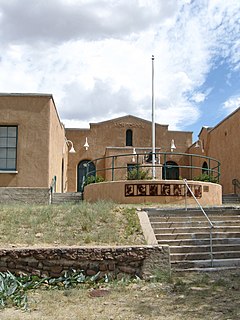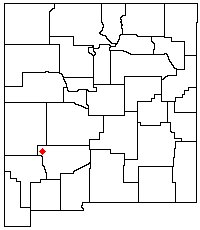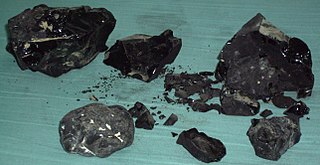
The Starr Mill Road Bridge is a historic bridge in Middletown, Connecticut. It is a single span Warren through truss bridge, spanning the Coginchaug River near the Starr Mill complex on the west bank of the river. Built in 1927 by the Berlin Construction Company, it is one of a shrinking number of period metal truss bridges in the state. The bridge was listed on the National Register of Historic Places in 1993. It is closed to all forms of passage.

The Fairfax Bridge is a steel-lattice three-hinged arch bridge spanning the Carbon River on State Route 165 in Pierce County, Washington. Previous to the construction of the bridge in 1921, the only route south to the area around Fairfax was by train. At a total cost of $80,000, the bridge's deck sits 250 feet (76 m) above the river.

The Rio Puerco Bridge is a Parker through truss bridge located on historic U.S. Route 66 (US 66), crossing the Rio Puerco, that was built in 1933. It is located approximately 19 miles (30 km) west of Albuquerque, New Mexico.
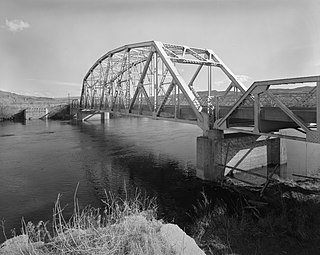
The CQA Four Mile Bridge spans the Big Horn River in Hot Springs County, Wyoming. The bridge was erected in 1927-28 by the Charles M. Smith Company and spans 175 feet (53 m) with a total length of 295 feet (90 m). The rigid 7-panel Pennsylvania through-truss was nominated for inclusion on the National Register of Historic Places as one of forty bridges throughout Wyoming that collectively illustrate steel truss construction, a technique of bridge design that has become obsolete since the mid-twentieth century. The bridge rests on concrete piers and abutments and is approached by two Warren pony trusses.

The EFP Bridge spans Owl Creek in Hot Springs County, Wyoming. The bridge was erected in 1919-20 by the Monarch Engineering Company of Denver and spans 124 feet (38 m) with a total length of 126 feet (38 m). The rigid 7-panel camelback through-truss was nominated for inclusion on the National Register of Historic Places as one of forty bridges throughout Wyoming that collectively illustrate steel truss construction, a technique of bridge design that has become obsolete since the mid-twentieth century. The bridge is supported on sandstone abutments and has a timber deck, 15 feet (4.6 m) in width.
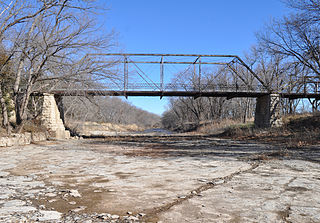
The Little Walnut River Pratt Truss Bridge is a Pratt truss bridge constructed shortly after 1885, in Bois d'Arc, Kansas. It was constructed by the Kansas City Bridge and Iron Company as a carriage, horse and pedestrian bridge over the Little Hickory Creek, which joins the Walnut River in southern Butler County. It was added to the National Register of Historic Places in 2003.

The Wilson Pratt Truss Bridge is a Pratt Truss bridge over the Chapman creek near Chapman, Kansas that was built in 1904. It was listed on the National Register of Historic Places in 2009. It was built by the Canton Bridge Co. and is an excellent example of this type of bridge along with the nearby Chapman Creek Pratt Truss Bridge. The bridge spanning the creek is 90 feet (27 m) long. It has a wood deck. There are two additional approach spans on either side of the bridge for a total length of 165 feet (50 m). Due to its location on a dirt road, it has been mostly left alone and does not carry much traffic. It is also denoted as 21-HT-1 and as KSHS Inventory # 041-0000-0169.
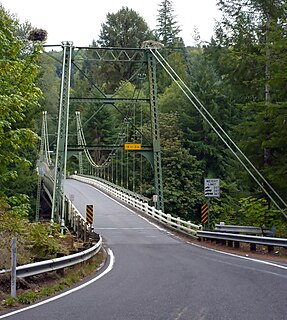
The Yale Bridge or Lewis River Bridge spans the Lewis River near Yale, Washington. It was built in 1932 by Cowlitz and Clark counties. The suspension bridge has a clear span of 300 feet (91 m), with a total length of 532 feet (162 m), replacing a previous steel truss bridge at the site. Construction of the Ariel Dam had created Lake Merwin with a water depth of 90 feet (27 m) at the site, requiring a new bridge that did not need to have support piers in the water. The road deck, stiffened by a steel Warren truss, is 50 feet (15 m) above the high water line of the reservoir.
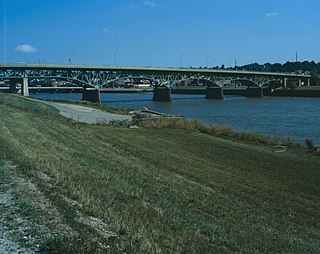
The Jefferson Street Viaduct is an historic structure located in Ottumwa, Iowa, United States. The riveted Warren deck truss bridge was completed in 1936. It was listed on the National Register of Historic Places in 1998 as a part of the Highway Bridges of Iowa MPS.

The AJX Bridge is a historic Pratt truss bridge in southwestern Johnson County, Wyoming. The bridge was built in 1931 across the South Fork of the Powder River near Kaycee, Wyoming. AJX Bridge was built to provide a river crossing for U.S. Route 87. It was placed on the National Register of Historic Places in 1985 as part of a Multiple Property Submission devoted to historic bridges in Wyoming.

The Indian Creek Bridge is a wrought iron bridge, built about 1880 to the east of Cedar Rapids, Iowa. The bridge crosses a tributary of the Cedar River in Linn County. It was designed and built by the Wrought Iron Bridge Company (WIBCO) of Canton, Ohio as an eight-panel pin-connected through truss in an unusual double-intersection Pratt design.
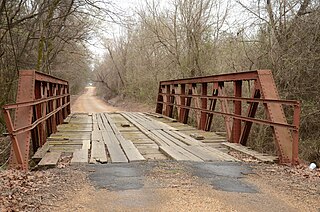
The McNeely Creek Bridge is a historic bridge spanning McNeely Creek just outside Beirne, Arkansas, a village in southwestern Clark County. The bridge, a steel Warren pony truss bridge with a span of 71 feet (22 m), carries County Route 12. Built in 1923, it has a wooden deck 18 feet (5.5 m) wide.

The Gilead Brook Bridge is a historic bridge which carries Vermont Route 12 across Gilead Brook north of the center of Bethel, Vermont. Built in 1928, it is one of four multi-span Warren deck truss bridges built in the state after extensive flooding in 1927. It was listed on the National Register of Historic Places in 1990.

The Waterman Covered Bridge was an historic covered bridge in Johnson, Vermont that carried Waterman Road across Waterman Creek. Built in 1868, it was one of three surviving 19th-century bridges in the town. It was listed on the National Register of Historic Places in 1974, and collapsed in January 1982.

The Williams River Route 5 Bridge is a historic Warren deck truss bridge, carrying U.S. Route 5 (US 5) across the Williams River in Rockingham, Vermont. Built in 1929 and rebuilt in 1971-72, it is one of four bridges of this type and vintage in the state. It was listed on the National Register of Historic Places in 1991.

The Big Piney Creek Bridge is a historic bridge, carrying Arkansas Highway 123 across Big Piney Creek in Ozark-St. Francis National Forest, northeast of Hagarville, Arkansas. Its main span is a Warren through truss structure, 141 feet (43 m) in length, with steel deck girder approach spans giving the bridge a total length of 461 feet (141 m). The trusses are mounted on concrete piers. The bridge was built in 1931, during a period of financial hardship, and was for economic reasons built with a single-lane 12-foot (3.7 m) roadway.

The Ottauquechee River Bridge is a steel girder bridge carrying United States Route 5 across the Ottauquechee River in Hartland, Vermont. The bridge replaced a c. 1930 Warren deck truss bridge, built in the wake of Vermont's devastating 1927 floods, and listed on the National Register of Historic Places in 1990.

The Holmes Street Bridge, also designated Bridge 4175, is a historic truss bridge over the Minnesota River in Shakopee, Minnesota, United States. It is one of the state's only examples of a deck truss bridge. It was constructed in 1927 with parts manufactured by the Minneapolis Steel & Machinery Company. The bridge was listed on the National Register of Historic Places in 2010 for having state-level significance in the theme of engineering. It was nominated for its rare design type and its fabrication by an important Minnesota bridge manufacturer.

The Allentown Bridge is a bridge spanning the Puerco River near Houck, Arizona, located in Apache County. The existing structure was completed in 1923 and is listed on the National Register of Historic Places.

The Ponca Creek Bridge, also known as NEHBS No. BD00-224, is a historic Pratt truss bridge spanning Ponca Creek that is listed on the National Register of Historic Places.

